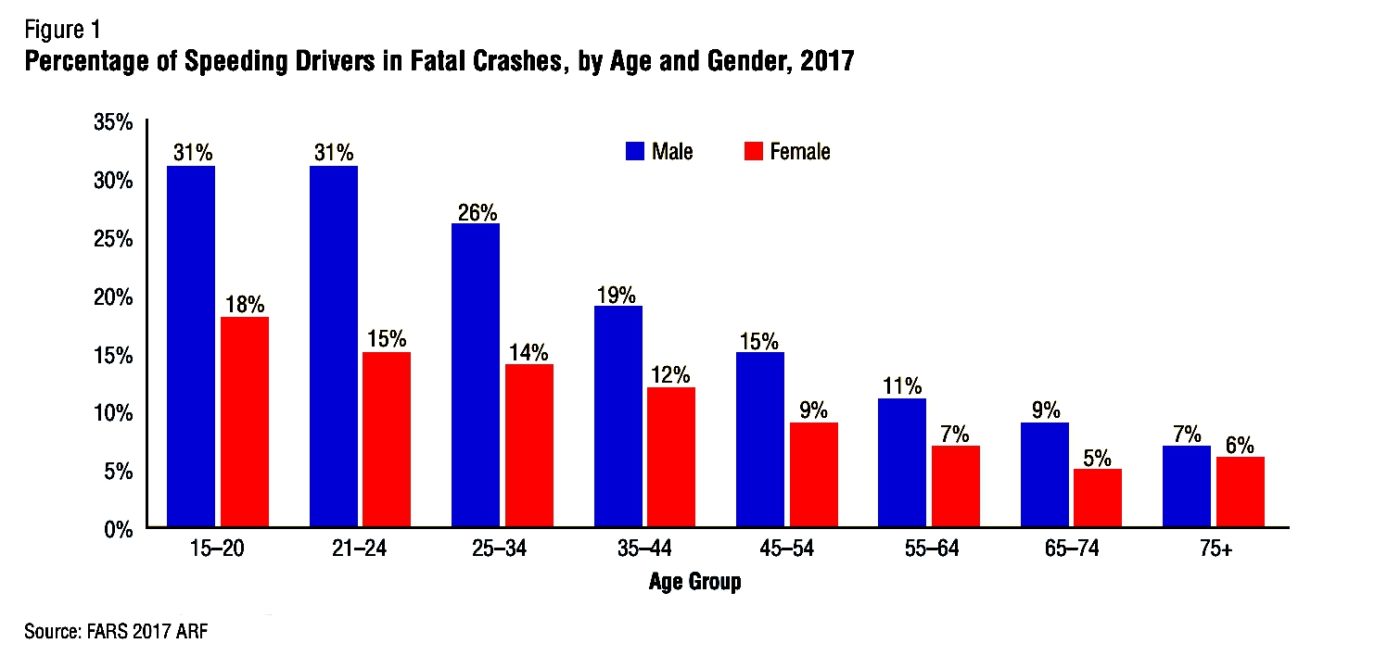Fatal traffic accidents occur on our nation’s roads and highways for a wide variety of reasons, but some driver behaviors cause more accidents than others. Several state and federal departments and agencies continually invest in research about the causes of traffic collisions. Knowing how and why they occur can help prevent future accidents and save lives. According to the National Highway Transportation Safety Administration (NHTSA), speeding remains the number one factor in more than 25 percent of fatal accidents each year, making it the number one cause of fatal accidents across the nation. Speeding while driving is a choice, a negligent choice, that can result in thousands of preventable deaths each year.
Below we dive deeper into why speeding leads to more fatalities, why drivers speed, the laws and penalties associated with speeding, common fatal injuries caused by speeding-related crashes, and what recourse you have if you lose a loved one as a result of a careless driver’s choice to speed.
We are a national law firm based in Houston with multiple offices around the country. We also work with affiliate law firms in most states that share our focus and dedication to excellence. No matter where you are located, we may be able to help you, so call or contact us now. We are open, for free, 24 hours a day, seven days a week, at 800-898-4877, or CONTACT US NOW by [CLICKING HERE] to submit your case for review.
Speeding Leads to More Fatalities Than Other Causes of Car Crashes
One of the first physics lessons we learn during grade school is Newton’s Second Law of Motion, which describes the relationship between force, mass, and acceleration with the formula F=MA (Force equals mass times acceleration). Traffic collisions with the most force upon impact are the most dangerous and fatal, and they involve large mass or high acceleration. Drivers who speed have increased the acceleration portion of the formula, creating greater force upon impact, causing more severe injuries and fatalities.
Heavy trucks, which can weigh up to 80,000 pounds when fully loaded, are especially dangerous when drivers speed. Their huge mass, at least 20 times more than a passenger vehicle, coupled with speeding, makes them especially dangerous. In addition to causing more severe crashes, speeding carries many other consequences according to the NHTSA, including:
- Loss of vehicle control. When drivers speed, it makes it more difficult to control their vehicles, especially if they encounter a road hazard or an erratic driver. Excess speed also makes it more difficult to steer safely around curves.
- Reduced effectiveness of safety equipment. Seat belts and airbags are far less likely to prevent injury or death at higher speeds.
- Increased stopping distance. The faster a vehicle is traveling, the more stopping distance it needs to avoid other vehicles and hazards.
- Expensive collisions. Speeding causes more severe collisions accompanied by increased property damage, larger medical expenses, and longer times away from work for recovery for injury.
- High fuel consumption. Speeding leads to using more gasoline, another factor that makes it an expensive choice.
Common Speeding Violations
Depending on where you are traveling, speeding laws vary. Yet, most states have two different categories of speeding laws, or one law that addresses both types of speeding. Speeding can refer to traveling over the posted speed limit or traveling too fast for conditions.
For example, Texas law states that drivers “may not drive a vehicle at a speed greater than is reasonable and prudent under the conditions and having regard for actual and potential hazards then existing; and shall control the speed of the vehicle as necessary to avoid colliding with another person or vehicle that is on or entering the highway in compliance with law and the duty of each person to use due care.”
Louisiana law provides another example: “No person shall drive a vehicle on the highway within this state at a speed greater than is reasonable and prudent under the conditions and potential hazards then existing, having due regard for the traffic on, and the surface and width of, the highway, and the condition of the weather, and in no event at a speed in excess of the maximum speeds established by this Chapter or regulation of the department made pursuant thereto.”
Similarly, California statutes state, “No person shall drive a vehicle upon a highway at a speed greater than is reasonable or prudent having due regard for weather, visibility, the traffic on, and the surface and width of, the highway, and in no event at a speed which endangers the safety of persons or property.” In addition, the California Vehicle Code sets out other provisions.
These broad speeding laws demonstrate the discretion law enforcement has to issue a citation in any situation they feel a driver is going faster than circumstances allow, regardless of the posted speed limit. While some state laws are more explicit than others, situations where drivers are often expected to slow down include:
- Approaching an intersection
- Approaching a railroad crossing
- Approaching the top of a hill
- While driving on narrow and/or winding roads
- When pedestrians are present
- When heavy traffic is present
- When road conditions or weather require a speed reduction
Law enforcement might issue a variety of speeding-related citations that carry various penalties, including fines and license suspension. Many states double fines for those who speed in construction zones. Those who speed in excess, typically defined as more than 20 miles over the posted speed limit, also face harsher penalties and might even receive a careless or reckless driving citation, especially if they have committed other traffic law violations. Penalties and fines typically increase when property damage or physical harm occurs as a result of speeding. When negligent drivers speed and cause the death of another driver or occupant, they might also face criminal vehicular manslaughter charges.
Speeding-Related Collisions Cause Fatal Injuries
When drivers speed, it leads to more severe accidents, which often cause catastrophic and fatal injuries for victims. Pedestrians, motorcycles, and bicyclists who are involved in a speed-related accident are at the highest risk for fatality. If victims do not die upon impact, they still face death from critical injuries. The following are examples of severe injuries that are often life-threatening:
Traumatic Brain Injuries (TBIs)
Mild traumatic brain injuries are concussions which often heal on their own within a few weeks. TBIs are a result of the impact of a car accident, which causes a jolt or blow to the head or causes direct blunt force trauma to the head. Severe TBIs can cause death at any point in a victim’s life. Sometimes complications might lead to death soon after an accident, and other times a severe TBI reduces a victim’s life span, causing death a few years later. The most dangerous TBIs cause a blood clot or bleeding in the brain. If you or a loved one has suffered a head injury in a car accident, the following symptoms sometimes indicate life-threatening issues:
- Worsening headache
- Repeated vomiting
- Slurred speech
- Inability to wake up
- Abnormally and unevenly sized pupils
- Convulsions
- Seizures
- Loss of consciousness
Spinal Cord Injuries (SCIs)
Victims of motor vehicle accidents that occur at high speeds are at risk for an acute spinal cord injury, which can sometimes be fatal. The extent of damage caused by a spinal cord injury depends on exactly where the cord was bruised, torn, or severed. Generally speaking, the higher an injury occurs on the spinal column, the worse the symptoms and a higher likelihood of fatality.
For example, an injury in the part of the spinal cord protected by the first five cervical vertebrae of the neck affects a person’s respiratory muscles and ability to breathe. Such injuries are often fatal or may require a victim to be permanently hooked up to a ventilator for the remainder of his or her life. Knowing this kind of injury could have been prevented if not for the actions of a negligent driver compounds the physical and emotional pain that accompanies this type of injury.
Internal Bleeding and Organ Injuries
Being involved in a speed-related traffic crash can lead to quite a few scenarios that might cause internal bleeding and organ injuries. With forceful impacts, bodies can get pinned, contorted, and tossed around, causing severe and potentially fatal injuries. Broken ribs can puncture organs as well as pieces of debris from the accident. Similarly, broken ribs can puncture lungs, causing them to fill up with fluid.
Another popular internal injury that occurs during a high impact traffic accident is an abdominal aortic aneurysm. This occurs when the stomach gets crushed during an accident and causes the aorta, the main vessel carrying blood to the heart, to rupture. Traffic accidents can also result in kidney damage, liver damage, and a ruptured spleen, as well as a variety of other potentially fatal internal injuries. When victims who suffer internal injuries from a car accident don’t receive immediate medical attention, death is often imminent.
Traumatic Amputation
A traumatic amputation occurs when the impact and force of a traffic crash sever a body part. When an accident causes complete amputation, sometimes victims live and may even have their body part reattached. When amputation occurs, victims suffer excessive bleeding, shock, and face the risk of infection. If accident victims are fortunate enough to receive immediate and exceptional medical treatment, they have an excellent chance of living. In other situations, failure to control bleeding, shock, and infection can together or separately lead to a fatality.
Risk Factors Associated With Speeding
Because speeding is the most common cause of fatal accidents, the National Highway Transportation Safety Administration (NHTSA) has devoted ample resources to study why people speed. Although it’s difficult to isolate the exact reasons why people speed, the NHTSA has identified four main risk factors:
Heavy traffic. Traffic congestion remains one of the most common factors associated with speeding and other aggressive driving habits.
- Running late. Drivers who have full and demanding schedules often have to race between destinations and try to make up lost time by speeding. The same thing goes for those who are constantly running late for work, school, events, meetings, and appointments.
- Feelings of anonymity. Some drivers have a sense of detachment from the outside when they are protected by the surroundings of their own vehicle. This promotes feelings of freedom from conforming to social norms, such as complying with traffic regulations. Drivers who feel like they are anonymous have no concern about speeding and other aggressive driving behaviors, because they believe it’s likely that they will never again see those who have witnessed their poor behavior.
- Outright disregard for the law and the safety of others. Some careless drivers choose to speed because it is their usual habit. They don’t believe traffic laws about speeding apply to them; and, they aren’t worried about whether their choices behind the wheel might cause injury or death to other motorists, pedestrians, cyclists, and others.
Recovering Compensation After a Fatal Accident Caused by Speeding
Losing a loved one in a fatal accident devastates surviving family members emotionally and financially in many cases. Contacting a skilled personal injury attorney who has experience with wrongful death lawsuits can help you through the aftermath of your loss. Depending on your relationship to the deceased, you may be eligible to seek compensation for your losses. A qualified attorney typically offers free, no-obligation consultations to evaluate a case and determine if there are valid grounds for a claim.
If you bring a wrongful death suit, and the court rules in your favor, you may collect multiple types of damages. Each state varies slightly, but there are some of the most common damages a court might award surviving family members after a fatal accident caused by speeding:
- Loss of support and service for those who were dependent on the deceased
- Loss of companionship for a spouse
- Emotional pain and suffering for spouse and/or minor children, for parents who survive the loss of a minor child, and for parents of an adult child
- Lost parental companionship, guidance, and instruction for minors
- Medical expenses from the traffic accident up until the time of death including hospital stay, ambulance services, surgery, radiology, and medication for any survivor who paid them.
- Burial costs and funeral expenses for any survivors who paid them
Contact an Experienced Auto Accident Lawyer Today for More Information
Fatal accidents are DEVASTATING life events. You don’t need to go through the emotional and financial pain, nor should you have to, when another driver caused the accident. Focus on coping with your loss and engaging in supportive activities with friends and family, and hire an experienced personal injury attorney who can help you get the compensation you deserve. If you lost a loved one in a fatal accident, call a motor vehicle accident lawyer immediately. Most will schedule a free consultation and work on a contingency fee, so there’s no cost to you.







